Menus
- Four mid-range bikes with full fairing in comparison
- Middle class comparison test part 1
- Middle class comparison test part 2
- Tips against the cold
- Technical data BMW F 800 ST
- Technical data Kawasaki ER-6f
- Technical data Suzuki GSF 650 F
- Technical data Yamaha XJ6 Diversion F
- Measurements
- Conclusion & Video
- Scoring
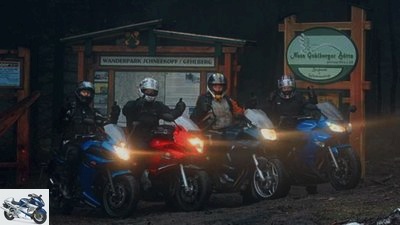
Gargolov
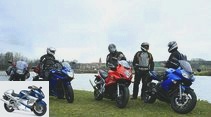
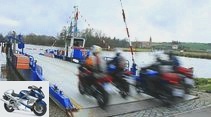
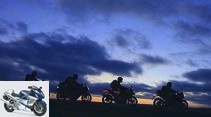
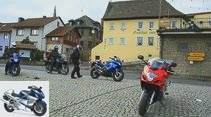
26th photos
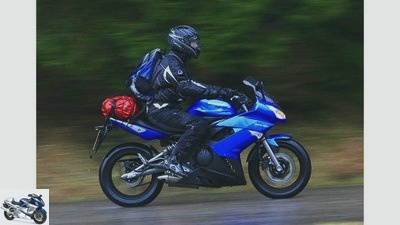
Gargolov
1/26
Kawasaki ER-6f: Inexpensive, compact, light and handy – the powerful parallel twin is fun, the chassis is sporty, firm and stable.
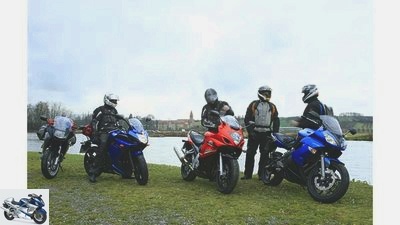
Gargolov
2/26
On a test tour with the fully faired mid-range motorcycles.
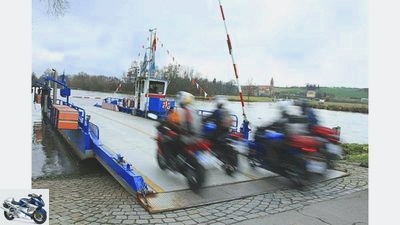
Gargolov
3/26
At Schweinfurt you take a ferry across the Main.
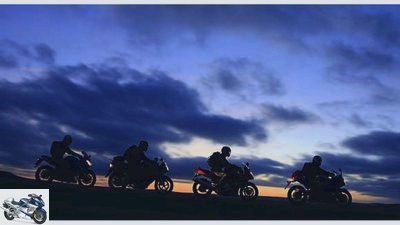
Gargolov
4/26
Wild West: Between the mountain ranges between Schweinfurt and Bad Konigshofen, the world is still fine in the evening.
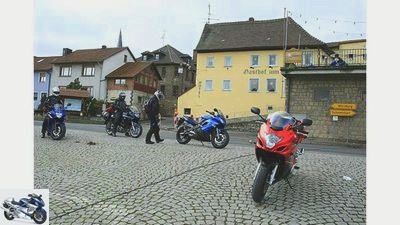
Gargolov
5/26
On a test tour with fully faired mid-range motorcycles.
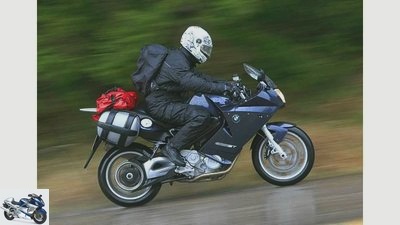
Gargolov
6/26
BMW F 800 ST: Very good brakes, good workmanship, best luggage storage in the field, but relatively expensive.
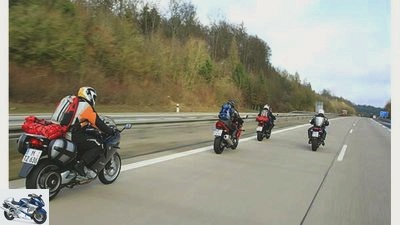
Gargolov
7/26
The team completed the first part of the tour on the motorway. Wind protection plays a major role here.
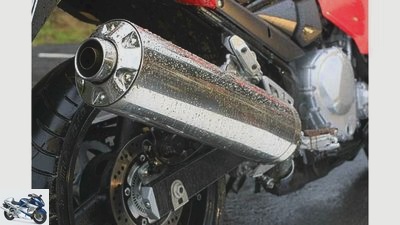
Gargolov
8/26
Suzuki GXF 650 F.
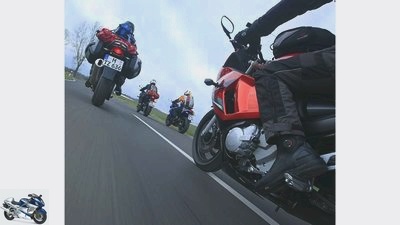
Gargolov
9/26
Something else is noticeable on the autobahn: in the ranges between 100 km / h and 160 km / h, the differences in performance between the four do not play that big a role.
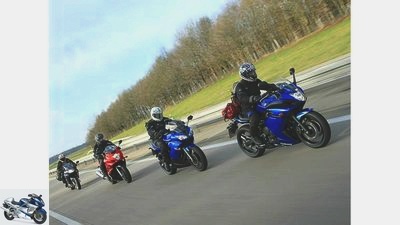
Gargolov
10/26
While the BMW presses 90 hp on the test bench, the Kawasaki brings up the rear with 73 hp. In between are the Suzuki (82 hp) and the Yamaha (75 hp). Sporty short gear ratios compensate for the performance deficits of the Yamaha and the Kawasaki.
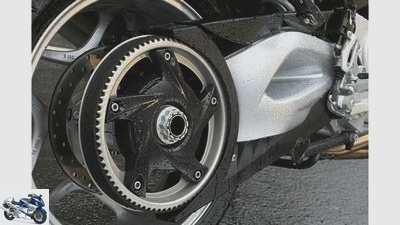
Gargolov
11/26
BMW F 800 ST
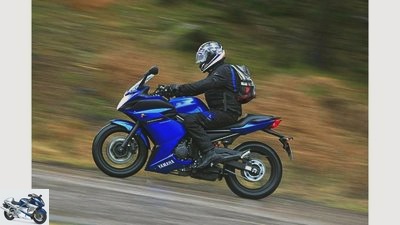
Gargolov
12/26
Yamaha XJ6 Diversion Q: Motorcycling can be so easy and beautiful: The XJ6 behaves perfectly even under the most adverse conditions.
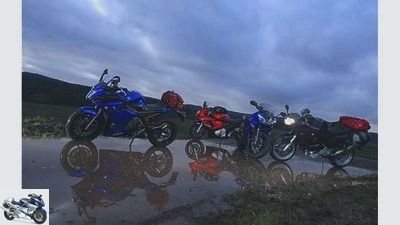
Gargolov
13/26
The test ride with the mid-range bikes was characterized by poor weather. In the special case of the trip, the MOTORRAD team relied on the onion skin principle with a very warm, breathable fleece directly on the skin, over it a thin wind stopper and jackets from various manufacturers.
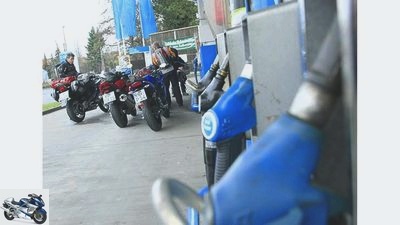
Gargolov
14/26
Costs: Here, the BMW shines with low consumption, low inspection costs and an additional mobility guarantee. Suzuki calculates relatively long inspection times for the 650s, while Yamaha and Kawasaki are insurable.
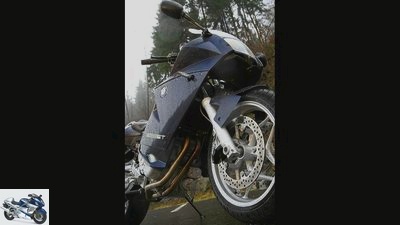
Gargolov
15/26
BMW F 800 ST: hands, upper body, legs moderately protected, strong turbulence on the helmet.
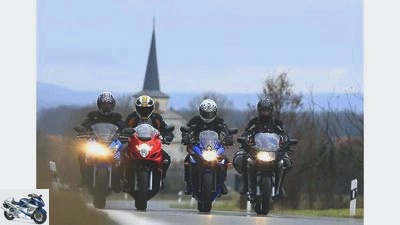
Gargolov
16/26
From left: Kawasaki ER-6f, Suzuki GSX 650 F, Yamaha XJ6 Diversion F and BMW F 800 ST.
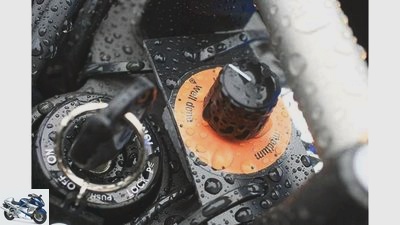
Gargolov
17/26
Retrofitted handle heating from CLS.
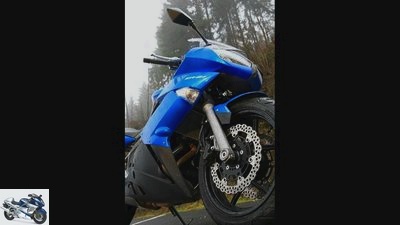
Gargolov
18/26
Kawasaki ER-6f: Almost no leg protection, only moderate protection for the upper body.
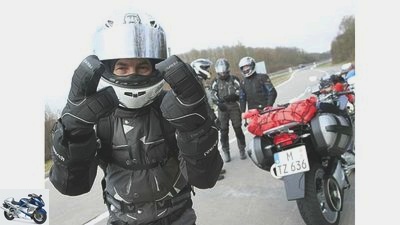
Gargolov
19/26
Where to go in winter Clear announcement: It should be tough, because the motorcycles should be tested under the most adverse conditions.
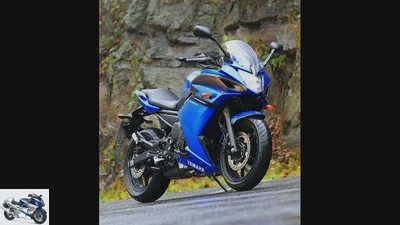
Gargolov
20/26
Yamaha XJ6 Diversion F: Hardly any turbulence in the helmet area, worst weather protection.
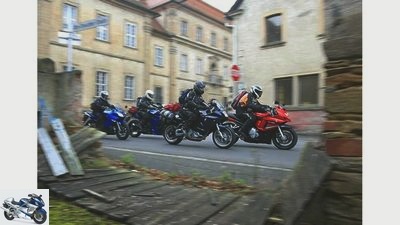
Gargolov
21/26
Wild East: Somewhere in the no man’s land between the Main and Hain, the photographer unpacks the flash system and illuminates the sadness of the December afternoon.
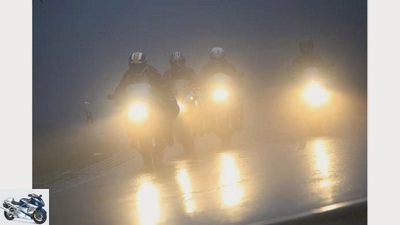
Gargolov
22/26
Thirst is worse than homesickness? Well, it can be. Poor visibility, cold and wet are definitely just as bad.
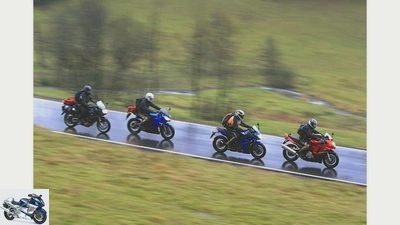
Gargolov
23/26
From left: BMW F 800 ST, Kawasaki ER-6f, Yamaha XJ6 Diversion F and Suzuki GSX 650 F.
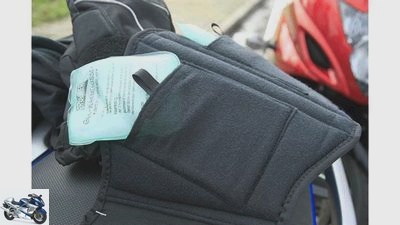
Gargolov
24/26
The idea is basically brilliant: gel cushions with bi-metal are placed in the kidney belt and give off cozy warmth. However, this works for a maximum of 60 minutes.
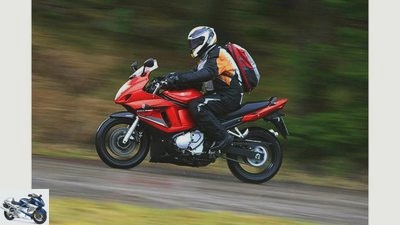
Gargolov
25/26
Suzuki GXF 650 F: The most adult motorcycle of the quartet with a classic look: long tank, wide seat, the driver sits far from the handlebars.
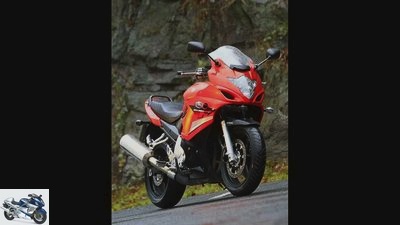
Gargolov
26/26
Suzuki GXF 650 F: Little turbulence, overall the fairing with the best protection.
Comparison test: faired mid-size motorcycles
Four mid-range bikes with full fairing in comparison
Winter – cold, rain, fog and maybe even snow .. So ideal conditions to really get to grips with the fully faired mid-range motorcycles, right??
Middle class comparison test part 1
E.s looks bad. The test team frozen through, rain-heavy clothes, zero visibility and asphalt with grip like soft soap. Yellow flashing lights rotate in the distance. A gritter approaches. Salt shines against the wheels of the test bikes. You don’t need to be a clairvoyant to know what’s going on in the drivers’ minds: Home! Right away! Warm bed, mulled wine, cuddly toy – it doesn’t matter. Everything but not this now. However, there are around 300 kilometers between the fulfillment of a wish and reality, because the sign for Meiningen in the Thuringian Forest is just disappearing in the rear-view mirrors. The warm nest is anything but within reach. What happened?
Buy complete article
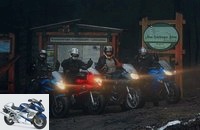
Comparison test: faired mid-size motorcycles
Four mid-range bikes with full fairing in comparison
ER-6f just 7195 euros, Suzuki for the GSX 650 F only 6990 euros. Aside from the price: which concept is better? The parallel twin of the Kawasaki? How positive is the 50 cubic capacity of the Suzuki? Or is it perhaps worth it to spend 2500 euros more and buy a BMW F 800 ST for just under 9800 euros? A comparison test should clarify that.
Gargolov
BMW F 800 ST: Very good brakes, good workmanship, best luggage storage in the field, but relatively expensive.
An endurance test that has it all. Because full fairing not only enhances motorcycles optically and makes them more aerodynamic, ideally they also protect the driver from wind and weather influences. What could be more natural than to chase the bikes through everyday German life in bad weather? Four men from the editorial team are lured with the promise of a great adventure. And they will be at the start on Wednesday, December 9th, exactly nine o’clock.
The temperature has bitten itself at eight degrees above zero, a low-hanging sun colors the horizon milky. But where do you put your luggage? No question about BMW. In addition to all sorts of extras such as an on-board computer (surcharge: 145 euros), electronic tire pressure control (205 euros) or LED indicators (95 euros), a proper luggage system has also been included (550 euros). But even without this, the BMW employee does not have to look long for possibilities if he wants to attach a pack sack. With the Suzuki this is still possible without any problems, and with the Kawa it is still possible, because there are small hooks and recesses, but the Yamaha is a disaster in this regard: No hooks, not even on the (pardon: more than modest) The rubber straps find the right hold on the passenger grab handle or on the passenger pegs.
40 minutes later, the machines turn onto the A81 and brace themselves against the icy east wind. And that hits the riders of the Kawasaki and Yamaha the hardest: shoulders, arms, hands and legs are almost unprotected in the wind. Difference here: The air flow on the Yamaha is more laminar, more even, the turbulence on the helmet and thus the volume not as intense as on the Kawasaki. Also with relatively strong turbulence on the helmet: the BMW. But the comparatively more expansive plastic shield of the F 800 ST protects the upper body and hands, in particular, from wind and cold much more effectively than that of the ER-6 or XJ6. However, the best disguise of the quartet offers the cheapest machine: On the Suzuki, the driver is well protected from the adversities of nature. In addition, the turbulence on the helmet is not that bad.
Gargolov
Kawasaki ER-6f: Inexpensive, compact, light and handy – the powerful parallel twin is fun, the chassis is sporty, firm and stable.
Something else is noticeable on the autobahn: in the ranges between 100 km / h and 160 km / h, the differences in performance between the four do not play that big a role. Only when overtaking beyond that does the BMW noticeably set itself apart due to its extra power. While the BMW presses 90 hp on the test bench, the Kawasaki brings up the rear with 73 hp. In between are the Suzuki (82 hp) and the Yamaha (75 hp). Sporty short gear ratios compensate for the performance deficits of the Yamaha and the Kawasaki. The Yamaha four-cylinder, which runs very gently, proves that this does not necessarily have to be at the expense of vibrations. Its vibrations are fine and hardly annoying. Even the expressions of life of the Kawa twin are still acceptable at constant speeds. The vibrations of the Suzuki four-cylinder and the BMW twin, on the other hand, are annoying in continuous operation.
Straight-line stability is good for all candidates. But the Yamaha and Kawasaki stir a little when they are stimulated, while the Suzuki and the BMW remain perfectly calm and stable in this regard. The concrete edges of the A81 reveal something else: the chassis of the GSX is insensitive. Anyone who changes from the very comfortably tuned Yamaha to the Suzuki will want to stop at the next rest stop to see whether the fork, shock absorber and wheels are correctly screwed on – every concrete groove, every scar on the road shakes the Suzuki chassis.
Middle class comparison test part 2




26th photos
Pictures: Comparison test: faired mid-range motorcycles
To home page
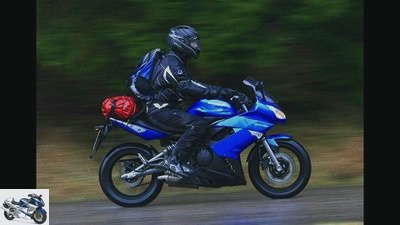
Gargolov
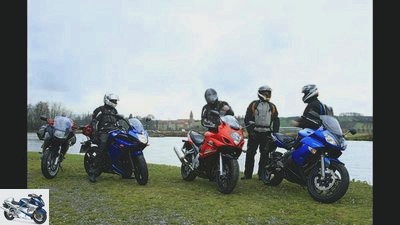
Gargolov
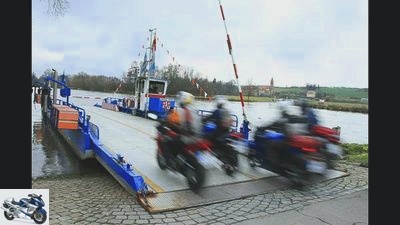
Gargolov
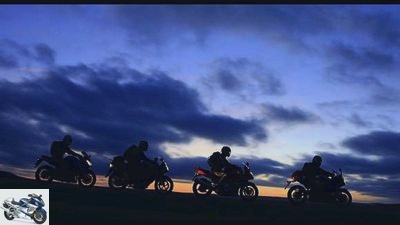
Gargolov
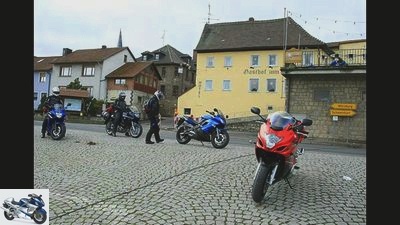
Gargolov
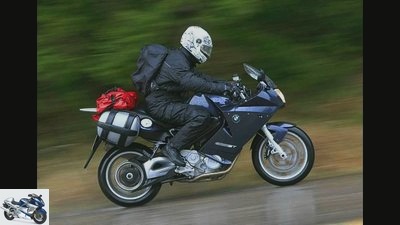
Gargolov
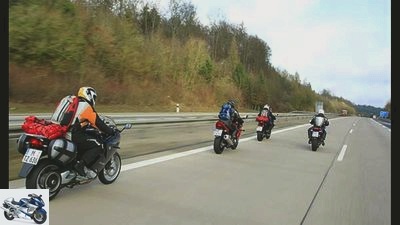
Gargolov
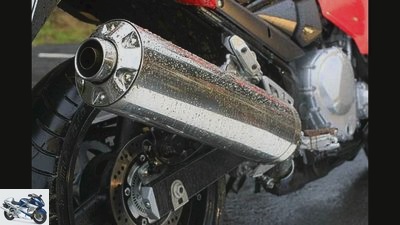
Gargolov
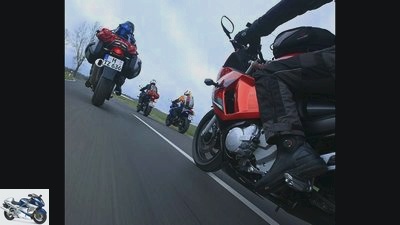
Gargolov
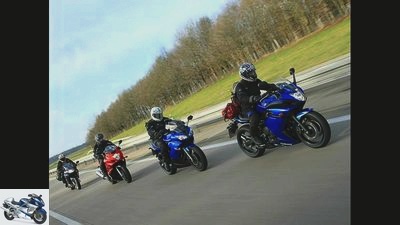
Gargolov
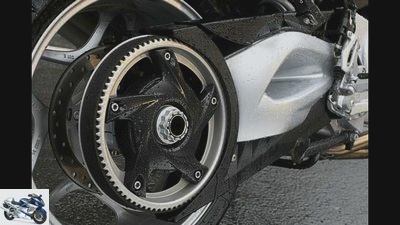
Gargolov
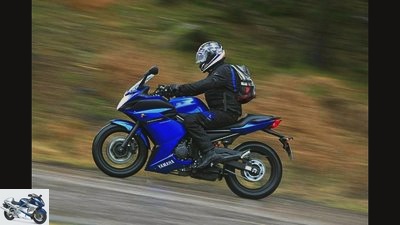
Gargolov
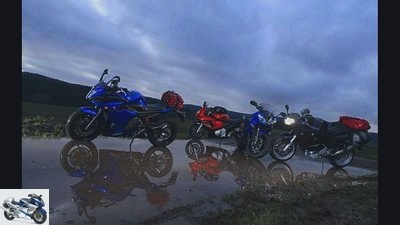
Gargolov
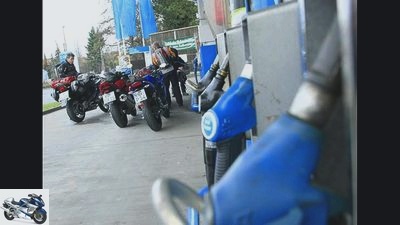
Gargolov
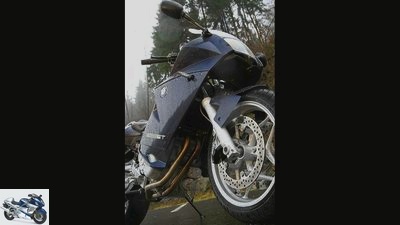
Gargolov
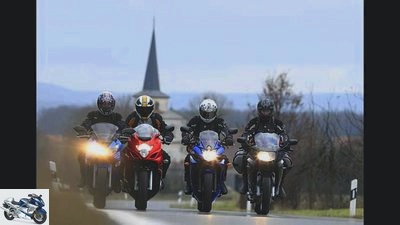
Gargolov
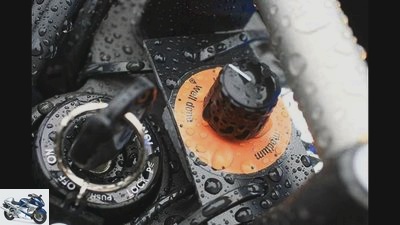
Gargolov
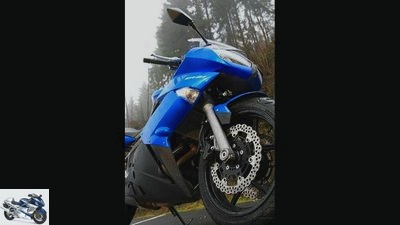
Gargolov
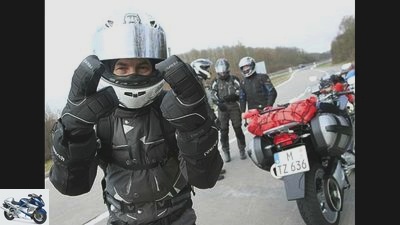
Gargolov
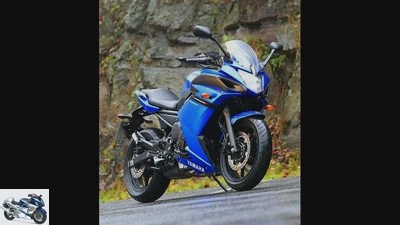
Gargolov
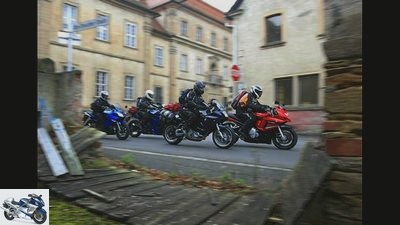
Gargolov
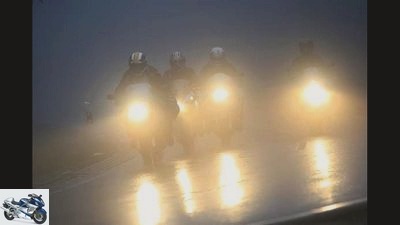
Gargolov
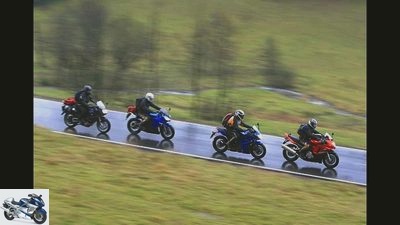
Gargolov
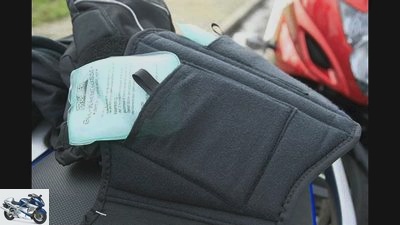
Gargolov
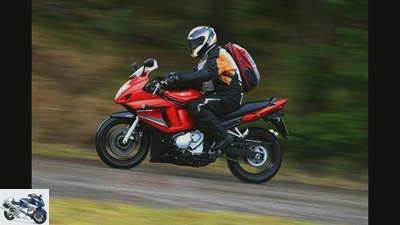
Gargolov
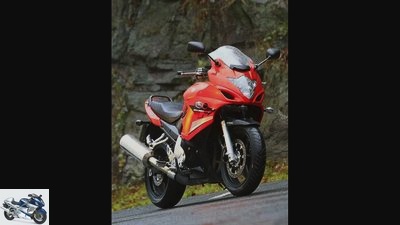
Gargolov
Mouse-gray skies, cow dung and dirt on the street, the morale of the troops decreases with the temperature. But the latter rises again after the flick of a button: while the BMW was equipped with heated grips ex works (195 euros extra charge), the other bikes were retrofitted with a system from CLS (199 euros) that regulates the heating output depending on the outside temperature. It works fine. With a diameter of 33 millimeters (BMW: 31 mm), the CLS grips are not much thicker than normal handlebar grips.
The roads don’t make it easy for the quartet: unreasonable, narrow, with constantly changing surfaces, little grip and tight radii. This is where the petite Yamaha comes into the spotlight. The very comfortably tuned chassis works almost like an elongated nerve and conveys infinite confidence. The driver gets an exact impression of the limit areas, grip and surface properties. In addition, the four-cylinder hangs super directly and gently on the gas, and the XJ6 steers with absolute precision and ease. Man and machine merge into one unit as if by themselves.
Gargolov
Suzuki GSF 650 F: The most mature motorcycle of the quartet with a classic look: long tank, wide seat, the driver sits far from the handlebars.
Unfortunately, the lightweight Kawa can’t really make use of its weight advantage under these conditions: The handiest machine in the comparison lacks a little feedback. The shock absorber looks trample, does not respond very sensitively. The fork is also set up quite tightly. Added to this is the sitting position that takes getting used to, in which the knees are strongly bent. The Suzuki is struggling with similar suspension problems. Here, too, there is no feedback, the responsiveness of the suspension elements is insensitive and does not build trust. The handling of the GSX is cumbersome. She demands more physical exercise than her Japanese colleagues, which is also due to her weight. Because of the toothed belt drive, the load change reactions of the BMW are harder than those of the chain-driven competition.
With a successful suspension set-up, which does not respond overly sensitive, but offers significantly more reserves (pillion ride) than the Yamaha chassis, the Bavarians have taken the golden mean. The fact that the BMW still looks clumsy in comparison and steers more slowly is due to the steering damper installed as standard and its Metzeler Roadtec Z6. Although this steers sluggishly, it has proven itself in the wet as well as the Bridgestone BT 021 mounted on the Kawasaki. The Dunlop Roadsmart attracted attention with the best grip and feedback (Yamaha). The Bridgestone BT 011 from Suzuki was the least convincing.
Gargolov
Yamaha XJ6 Diversion Q: Motorcycling can be so easy and beautiful: The XJ6 behaves perfectly even under the most adverse conditions.
Night has fallen over the horizon like a slap in the face. The MOTORRAD team stops near Zella Mehlis. The next morning the temperature dropped to one degree. It’s raining like buckets. In addition, there is fog, which reduces the view to long jump distance. The tanks are filled. The average consumption over 250 kilometers of country roads is higher than that determined on the MOTORRAD standard lap and which is decisive for the point evaluation. BMW: 5.1 liters, Kawasaki: 5.2 liters, Suzuki: 5.6 liters and Yamaha 5.5 liters per 100 kilometers. Over water-reflecting asphalt and through clouds of fog, we continue into the Thuringian Forest.
The airflow pushes the spray that has been blown up through the fairing hood of the ER-6f directly onto the driver’s legs. So much for weather protection. The Yamaha rider also quickly feels left out in the rain. Thank goodness all candidates can rely on ABS-assisted brakes. There are no outliers here, the controllability of all systems is at a high level. The braking effect, on the other hand, is strongest with the BMW, the ABS control behavior the finest. In good company, you stand at the Thuringian bratwurst stand in Meinigen, dripping with moisture, and ponder: Yamaha’s handy XJ6 works best under these adverse conditions because the driver can fully concentrate on driving. The great chassis feedback and the unbelievable ease with which the machine turns in make her the perfect partner for extreme conditions. She is the winner of the heart, even if the BMW can do a lot better. The 800 is a good motorcycle, but it cannot show its advantages in bad weather. If you are looking for a powerful, powerful motor for little money, you cannot ignore the ER-6f. And prospective touring riders who would rather invest their money in kilometers than in image are best served by the Suzuki. For little money there is an acceptable windbreak, a fatigue-free seat position and the largest load capacity. The day is far from over. Hardly in the saddle again, the spreader comes towards you.
Tips against the cold
Gargolov
It’s foggy and raining. The temperature is around freezing. Anyone wearing the wrong one now gets problems.
Thirst is worse than homesickness? Well, it can be. Cold and wet are definitely just as bad. In the special case of the trip, the MOTORRAD team relied on the onion skin principle with a very warm, breathable fleece directly on the skin, over it a thin wind stopper and jackets from various manufacturers. The BMW Streetguard III driver’s suit and the Stadler Transair II suit are particularly effective (as they are absolutely waterproof, warm and robust). Windproof, warm balaclavas are essential in these conditions. A little tip for bald people: The Windmaster model from Restless is the most comfortable to wear. The best tip for the cold season are jackets with an air chamber system (example: Stadler Traveler and Rukka APR Airvision). If necessary, air is simply blown into the vests on the inside – the optimum insulation. It hardly gets any warmer.
Gargolov
Heat pillows work wonders, but unfortunately only for an hour.
The idea is basically brilliant: gel cushions with bi-metal are placed in the kidney belt and give off cozy warmth. However, this works for a maximum of 60 minutes. Then the pillows have to go back into the hot water for ten minutes to melt the gel again. They are then ready for use again. Buckling activates them. Then the heat is emitted (unfortunately again only) for an hour. If you drive for a long time, you should have an appropriate supply. The double-walled Pinlock visor, which guarantees a clear view in 95 percent of all driving situations, unfortunately no longer worked at temperatures around freezing point plus fog and rain and fogged up.
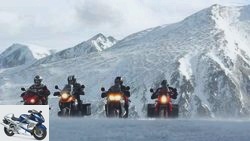
clothing
Buying advice: winter equipment
Equipment tips for frost and snow
read more
Technical data BMW F 800 ST
Gargolov
With the BMW, hands, upper body and legs are moderately protected and there is strong turbulence on the helmet.
engine
Water-cooled two-cylinder four-stroke in-line engine, two overhead, chain-driven camshafts, four valves per cylinder, bucket tappets, dry sump lubrication, injection, Ø 46 mm, regulated catalytic converter, 400 W alternator, 12 V / 14 Ah battery, mechanically operated multi-disc oil bath clutch, six-speed gearbox, Toothed belt, secondary transmission 2.353.
Bore x stroke 82.0 x 75.6 mm
Displacement 798 cm3
Compression ratio 12.0: 1
rated capacity 62.5 kW (85 PS) at 8000 rpm
Max. Torque 86 Nm at 5800 rpm
landing gear
Bridge frame made of aluminum, telescopic fork, Ø 43 mm, single-sided swing arm made of aluminum, central spring strut, directly hinged, adjustable spring base, double disc brake at the front, Ø 320 mm, four-piston fixed calipers, disc brake at the rear, Ø 265 mm, two-piston fixed caliper. Cast aluminum wheels 3.50 x 17; 5.50 x 17
Tires 120/70 ZR 17; 180/55 ZR 17
Tires in the test Metzeler Roadtec Z 6, rear “E”
mass and weight
Wheelbase 1466 mm, steering head angle 63.8 degrees, caster 95 mm, spring travel f / r 140/140 mm, seat height * 840 mm, weight with a full tank * 218 kg, payload * 187 kg, tank capacity / reserve 16.0 / 4.0 liters.
Guarantee two years
Mobility guarantee two years
Service intervals 10000 km
Colours Blue-bronze metallic
price 9770 euros
Price test motorcycle** 11807 euros
Additional costs around 262 euros
* MOTORCYCLE measurements
** including ABS (710 euros), heated grips (195 euros), RDC tire pressure control (205 euros), on-board computer (145 euros), LED indicators (95 euros), main stand (110 euros), case holder (70 euros), sports case (480 euros) Euro), locking rate (25 Euro)
Technical data Kawasaki ER-6f
Gargolov
The Kawasaki has almost no leg protection and only moderate protection for the upper body.
engine
Water-cooled two-cylinder four-stroke in-line engine, two overhead, gear-driven camshafts, four valves per cylinder, fork rocker arms, dry sump lubrication, injection, Ø 38 mm, regulated catalytic converter, alternator 336 W, battery 12 V / 14 Ah, mechanically operated multi-plate oil bath clutch, six-speed gearbox O-ring chain, secondary ratio 46:15.
Bore x stroke 83.0 x 60.0 mm
Cubic capacity 649 cm3
Compression ratio 11.2: 1
rated capacity 53.0 kW (72 hp) at 8500 rpm
Max. Torque 66 Nm at 7000 rpm
landing gear
Steel tubular frame, load-bearing motor, telescopic fork, Ø 41 mm, two-arm swing arm made of steel, suspension strut, directly hinged, adjustable spring base, double disc brake at the front, Ø 300 mm, double-piston floating calipers, rear disc brake, Ø 220 mm, single-piston floating caliper, ABS.
Cast aluminum wheels 3.50 x 17; 4.50 x 17
Tires 120/70 ZR 17; 160/60 ZR 17
Tires in the test Bridgestone BT 021 “J”
mass and weight
Wheelbase 1410 mm, steering head angle 65.0 degrees, caster 106 mm, spring travel f / h 120/125 mm, seat height * 800 mm, weight with a full tank * 208 kg, payload * 176 kg, tank capacity 15.5 liters.
guarantee two years
Service intervals 6000 km
Colours Black, green, white
price 7195 euros
Additional costs around 180 euros
* MOTORCYCLE measurements
Technical data Suzuki GSF 650 F
Gargolov
With the Suzuki there is little turbulence and overall it has the fairing with the best protection.
engine
Water-cooled four-cylinder four-stroke in-line engine, two overhead, chain-driven camshafts, four valves per cylinder, bucket tappets, wet sump lubrication, injection, Ø 36 mm, regulated catalytic converter with secondary air system, 400 W alternator, 12 V / 10 Ah battery, mechanically operated multi-disc oil bath clutch, Six-speed gearbox, O-ring chain, secondary ratio 48:15.
Bore x stroke 65.5 x 48.7 mm
Displacement 656 cm3
Compression ratio 11.5: 1
rated capacity 63.0 kW (86 PS) at 10500 rpm
Max. Torque 62 Nm at 8900 rpm
landing gear
Double loop frame made of steel, telescopic fork, Ø 41 mm, adjustable spring base, two-arm swing arm made of steel, central spring strut with lever system, adjustable spring base and rebound damping, double disc brake at the front, Ø 310 mm, four-piston fixed calipers, disc brake at the rear, Ø 240 mm, single-piston floating caliper, ABS.
Cast aluminum wheels 3.50 x 17; 5.00 x 17
Tires 120/70 ZR 17; 160/60 ZR 17
Tires in the test Bridgestone BT 011 front “N”, 010 rear “G”
mass and weight
Wheelbase 1470 mm, steering head angle 64.0 degrees, caster 108 mm, suspension travel f / h 130/128 mm, seat height * 800 mm, weight with a full tank * 245 kg, payload * 210 kg, tank capacity 19.0 liters.
guarantee two years
Service intervals 6000 km
Colours Black, black / white, blue / white
price 6990 euros
Additional costs around 135 euros
* MOTORCYCLE measurements
Technical data Yamaha XJ6 Diversion F
Gargolov
The Yamaha hardly has any turbulence in the helmet area, but the worst weather protection.
engine
Water-cooled four-cylinder four-stroke in-line engine, two overhead, chain-driven camshafts, four valves per cylinder, bucket tappets, wet sump lubrication, injection, Ø 32 mm, regulated catalytic converter, 330 W alternator, 12 V / 10 Ah battery, mechanically operated multi-disc oil bath clutch, six-speed gearbox, O-ring chain, secondary ratio 46:16.
Bore x stroke 65.5 x 44.5 mm
Cubic capacity 600 cm3
Compression ratio 12.2: 1
rated capacity 57.0 kW (78 hp) at 10,000 rpm
Max. Torque 60 Nm at 8500 rpm
landing gear
Bridge frame made of steel, telescopic fork, Ø 41 mm, two-arm swing arm made of steel, central spring strut, directly hinged, adjustable spring base, double disc brake at the front, Ø 298 mm, double-piston floating calipers, rear disc brake, Ø 245 mm, single-piston floating caliper, ABS.
Cast aluminum wheels 3.50 x 17; 4.50 x 17
Tires 120/70 ZR 17; 160/60 ZR 17
Dunlop Roadsmart “L” tires tested
mass and weight
Wheelbase 1440 mm, steering head angle 64.0 degrees, caster 104 mm, spring travel f / h 130/130 mm, seat height * 805 mm, weight with a full tank * 220 kg, payload * 180 kg, tank capacity 17.3 liters.
guarantee two years
Service intervals 10000 km
Colours White, black, red
price 7495 euros
Additional costs around 170 euros
* MOTORCYCLE measurements
Measurements
Gargolov
Performance diagram: BMW F 800 ST, Kawasaki ER-6f, Suzuki GSX 650 F and Yamaha XJ6 Diversion F. Power on the crankshaft. Measurements on Dynojet roller dynamometer 250.
Despite the comparatively modest torque, the XJ6 can keep up well with its successful transmission in pulling. Both Yamaha and Suzuki have developed a very homogeneous power delivery in their four-cylinder engines, while the two-cylinder engines from BMW and Kawasaki tend to abrupt performance jumps in the medium speed range. Nevertheless: The nominally weakest engine of the ER-6f shines in the technically relevant, medium speed range with astonishingly much power.
Top speed
| Manufacturer information | Km / h |
| BMW | 220 | Kawasaki | 210 |
| Suzuki | 205 | Yamaha | 205 |
acceleration
| Manufacturer information | 0-100 km / h (in seconds) |
0-140 km / h (in seconds) |
0-200 km / h (in seconds) |
BMW | 3.8 | 6.5 | 16.7 |
| Kawasaki | 3.9 | 7.4 | 23.9 | Suzuki | 4.2 | 7.4 | 21.2 |
| Yamaha | 3.9 | 7.3 | 26.7 |
Draft
| Manufacturer information | 60-100 km / h (in seconds) |
100-140 km / h (in seconds) |
140-180 km / h (in seconds) |
BMW | 4.5 | 5.1 | 6.1 |
| Kawasaki | 4.6 | 5.1 | 6.4 | Suzuki | 5.0 | 5.6 | 7.4 |
| Yamaha | 4.7 | 5.2 | 7.4 |
Fuel consumption (on the country road)
| Manufacturer information | Liters / 100 km |
BMW | 3.9 |
| Kawasaki | 4.2 | Suzuki | 4.6 |
| Yamaha | 4.1 |
Theoretical range (on the country road)
| Manufacturer information | Km | BMW | 410 |
| Kawasaki | 369 | Suzuki | 413 |
| Yamaha | 422 |
Conclusion & Video




26th photos
Pictures: Comparison test: faired mid-range motorcycles
To home page

Gargolov

Gargolov

Gargolov

Gargolov

Gargolov

Gargolov

Gargolov

Gargolov

Gargolov

Gargolov

Gargolov

Gargolov

Gargolov

Gargolov

Gargolov

Gargolov

Gargolov

Gargolov

Gargolov

Gargolov

Gargolov

Gargolov

Gargolov

Gargolov

Gargolov

Gargolov
Yamaha XJ6 Diversion F.
Small, handy, nimble – a bike that meets almost all requirements despite its low insurance 78 hp. With cutbacks in pillion operation and luggage storage.
3rd place: Suzuki GSX 650 F
Inexpensive and good. What more do you want? The handling of the machine is comparatively slow, but the touring qualities and the stable chassis score.
4th place: Kawasaki ER-6f
The robust parallel twin is fun, but the seating position that takes getting used to and the lean equipment prevent better placement here.
Subscribe to MOTORRAD videos on Youtube
Scoring
Classification engine – winner: BMW
Old basic rule: There is no substitute for displacement. Nevertheless, the BMW lost its capacity bonus through too long a gear ratio and a small drop in torque at 4000 rpm – the lower-capacity Kawasaki shines with almost identical torque thanks to a better gear ratio. In addition, it has more power than the four-cylinder in lower and medium engine speeds. The Yamaha four-cylinder, with its crisp, short translation, is pleasing with its silky-smooth response, precise, smooth clutch and gearshift, as well as its smooth running. Weaknesses in the ER-6f and the GSX 650 F: The couplings could separate more precisely and easily. And the gearbox of the Suzuki is quite difficult to shift.
Chassis rating – winner: BMW
Almost like a toy: The Yamaha is so relaxed, easy and lively like no other. It shines with excellent feedback, the best comfort and, due to its comfortable chassis setting, only makes a mistake in two-person operation. Because here the strut is quickly exhausted and the chassis reserves are used up. In direct comparison with the nimble, extremely light-footed Yamaha, the BMW looks old. Although it offers the largest chassis reserves and shines in pillion operation, the steering behavior is tough, to which the standard steering damper also plays its part. On the chassis side, Kawa and Suzi are relatively sporty and tightly tuned, which promotes stability, but reduces comfort.
Everyday life – winner: BMW
Bigger is better: The motto is not new. When it comes to wind and weather protection, it hits the mark. Here the Suzuki can move into the spotlight, because both small and medium-sized drivers feel best protected behind their fairing. The BMW disappoints with turbulence behind the window, but scores again with the best pillion seat. The narrow, sporty full fairings of the Yamaha and Kawasaki offer almost no protection for the rider’s legs. The ER-6f makes a mistake with its mirrors, because in them you can hardly see anything other than forearms. The high payload of 210 kilograms for the Bandit is particularly praiseworthy. Particularly reprehensible: the limited luggage storage facility on the XJ6.
Safety rating – winner: BMW
None falls through the grid: The braking systems of all bikes are all supported by ABS, the deceleration is at an acceptable level, and thanks to the best ABS control behavior, the BMW shines with the shortest braking distances. Handlebar slap is not acute with any model, especially with the Kawa and BMW. Rather, on the other hand, with the Yamaha and the Suzuki, which in this respect can react quite sensitively to bumps when accelerating fully.
Evaluation of costs – winner: BMW
Shines here the BMW with low consumption, low inspection costs and an additional mobility guarantee. Suzuki calculates relatively long inspection times for the 650s, while Yamaha and Kawasaki are insurable.
| maximum number of points |
BMW | Kawasaki | Suzuki | Yamaha | Overall rating | 1000 | 660 | 612 | 613 | 624 |
| placement | 1. | 4th. | 3. | 2. | Price-performance note | Top grade: 1.0 | 1.7 | 1.4 | 1.4 | 1.3 |
Price-performance winner: Yamaha
It is beginner-friendly and has proven its worth even under extreme conditions: the XJ6 makes almost everyone happy who is not often out and about in pairs.

clothing
Buying advice: winter equipment
Equipment tips for frost and snow
read more
Related articles
-
Comparison test of naked bikes from Japan
Art 15 pictures Art 1/15 Art 2/15 Art 3/15 Art 4/15 Art 5/15 Art 6/15 Art 7/15 Art 8/15 Art 9/15 Art 10/15 …
-
Comparison test touring enduro bikes: Honda Transalp, Kawasaki Versys, Suzuki V-Strom 650
Jahn comparison test travel enduro: Honda Transalp, Kawasaki Versys, Suzuki V-Strom 650 Always on the wall, travel enduro does not necessarily mean BMW …
-
Comparison test of the mid-range all-rounder
Gargolov comparison test middle class all-rounder, Honda CBF 600 / S, Honda Hornet 600, Kawasaki Z 750, Suzuki Bandit 600, Suzuki SV 650 / X, Yamaha FZ6 We …
-
Comparison test of naked bikes with ABS
fact comparison test of naked bikes with ABS Veni, vidi, vici! In comparative tests and approval numbers, the all-rounders Honda CBF 600, Kawasaki ER-6n …
-
fact Comparison test Big Bikes, BMW K 1200 S, Honda CBR 1100 XX Blackbird, Kawasaki Ninja ZX-12R, Kawasaki ZZR 1400, Suzuki GSX 1300 R Hayabusa Enough is…
-
Comparison test of mid-range tourers
Comparison test of the middle class tourer Green Week Curves over curves in the midst of oxygen-rich forests and lush green meadows. The Thuringian Forest offers …
-
Gargolov Comparison test big bikes: Honda CBR 1100 XX Super Blackbird, Kawasaki Ninja ZX-12R, Suzuki GSX 1300 R Hayabusa, Yamaha FJR 1300 A Two fast, two…
-
Comparison test of enduro bikes
Comparison test Enduros last groove How much leisure fun can be had with everyday enduros like the XT 600 E, the KLR 650 or the new DR 650 SE? On…
-
Comparison test: mid-range naked bikes 2011
Jahn 28 pictures Jahn 1/28 The mountain calls: Up the Watzmann with the test bikes BMW F 800 R, Kawasaki Z 750 R and Yamaha FZ8. Jahn 2/28 comparison test: …
-
Middle class naked bikes in comparison test
r-photography.info 30 pictures r-photography.info 1/30 With the Z 900 Kawasaki pushes the middle class close to the full liter. Looks up …